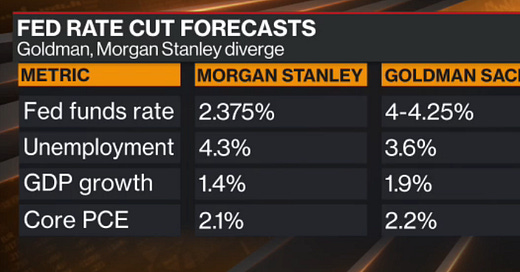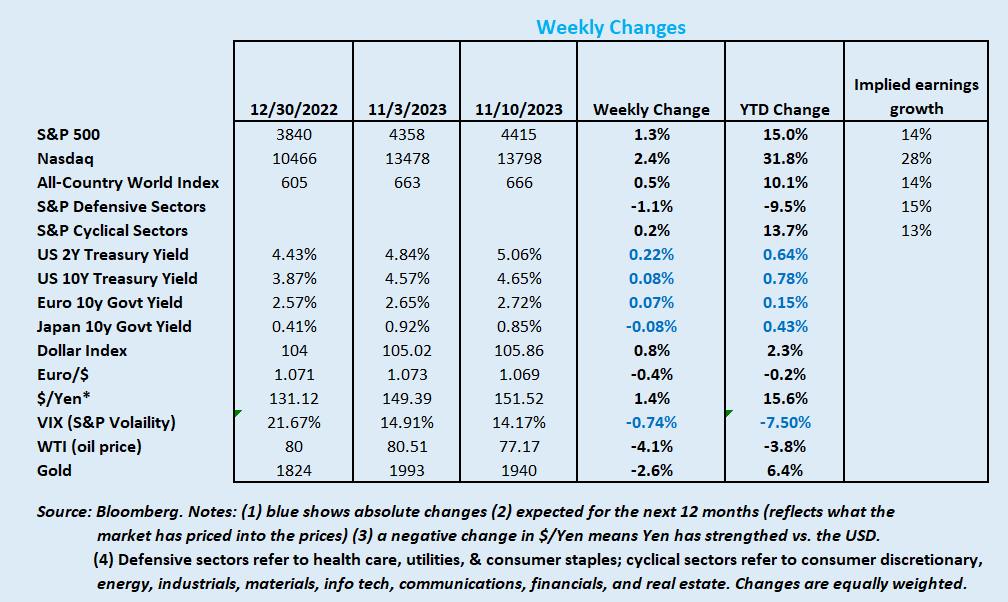Weekly Good Reads: 5-1-1
APEC, inflation expectations, global economic slowdown, investing lessons, EV market share, and $7 latte
Welcome to Weekly Good Reads 5-1-1 by Marianne O, an investment practitioner and author of
about investing, economy and wellness ideas. Every week I include 5 links to relevant economic and investment, finance and wellness/idea pursuit as well as 1 important chart and 1 term to know. All the Weeklies are here and here is the index of charts and terms. You can easily subscribe to my newsletter by clicking below.Thank you so much for reading and supporting my work 🙏.
Market and Data Comments
The stock market, especially the technology sector, continued to rise last week. The Nasdaq is about 4% lower from its YTD peak on July 19. The 2-year Treasury yield spiked up 22bp as last week the University of Michigan’s sentiment survey showed consumers ramped up inflation expectations in November, rising to 4.4% from 4.2% last month.
The Fed is likely to be concerned about the surge in the 5 to 10-year inflation expectations to 3.2% from 3% prior, the highest reading since 2011. The Fed looks open to one more interest rate hike in December or early 2024.
However, other indicators from the US showed more economic slowdown: (1) headline consumer sentiment index dropped to 60.4 in the preliminary November report, below the consensus of 63.7. (2) The Fed’s Senior Loan Officer Opinion Survey showed banks continued to tighten commercial credit through October (3) Continuing jobless claims climbed, which can push the 3.8% unemployment rate higher.
In general, with higher yields and borrowing costs, higher inflation expectations, and more supply of bonds, the world is concerned about how much economies will slow down. US has held up the best but economic resilience is losing momentum. At the same time, inflation expectations have ticked up. Chairman Powell and other Fed governors last week left the door to further hikes wide open should data warrant them.
Europe and the UK, with their weaker economies, will have likely finished rate hikes, and countries such as China have continued to ease. In 2024, the rate cycle around the world will be more diverged than in 2023. Even the Wall Street strategists have pretty diverged opinions about rate movement in the US in 2024 (see chart above) despite their similar growth and core PCE outlook.
This week we will monitor the week-long APEC meeting and announcements and the Biden and Xi meeting (Wednesday), the US October CPI and the ECB Chief Economist speaking about Global Risk, Uncertainty and Volatility (Zurich) on Tuesday, US October retail sales and PPI on Wednesday, US October industrial production and NAHB housing market on Thursday, and US October housing starts on Friday (lots of data!). Results from China’s Singles Day, the biggest online shopping event, are also of interest and the US funding deadline (end of next week) is also important.
Economy and Investments (Links):
Buffett’s Cash at Record $157 Billion After Deal Slump (Yahoo Finance/Bloomberg)
How China's BYD Went From Bargain Battery Maker to Tesla's Biggest Rival (Nikkei Asia)
What Could Go Wrong (exploring federal budget data) (John Mauldin - Frontline)
Finance/Wealth (Link):
11 Things I Learned About Investing (@The Alchemy of Money substack)
Love this advice in particular from the piece:
Finally, you don’t become a great investor by reading about other great investors. Don’t let learning turn into procrastination. If you want to become a better investor, invest. Remember what Charlie Munger said about the young man asking advice from Mozart:
A young man of 25 or so once asked to see Mozart and he said, ‘I’m thinking of starting to write symphonies, and I’d like to get your advice.’ And Mozart said, ‘Well, you’re too young to write symphonies.’ And the guy says, ‘But you were writing them when you were ten-years-old.’ And Mozart says, ‘Yes, but I wasn’t asking anybody else for advice on how to do it.
Wellness/Idea (Link):
Why Your $7 Latte is $7 (Vox)
The price of a fancy drink whether you are in the US or in Hong Kong (where I just visited) has a base price of US$6 (before customization), and in HK, this is equivalent to a set lunch meal (which includes food and drink) at a HK-style cafe for the locals. The high cost of the fancy drink is due to the rise in food costs and wages. For example at Starbucks, to mitigate unionization, management has raised baristas’ wages significantly. But people are still lining up for these fancier drinks. Perhaps buying a special cup of coffee/tea to catch a break or your breath is indeed valuable.
One Chart You Should Not Miss: Electric Vehicle Market Share
Chartr shared an interesting article on Tesla
Despite the technological leaps made in the sector, the vast majority of drivers haven’t made the switch from gas to electric. High costs and "range anxiety" have fueled hesitation, leading many to opt for hybrids, which have outpaced EV sales this year. Perhaps surprisingly, just 8.6% of all auto sales in Q3 in the US were all electric. Tesla sees this as an opportunity, with an ambitious target to manufacture 20 million cars annually by 2030, double the current output of today's top manufacturer, Toyota. (Chartr)
The message is: that there are tons of opportunities for EV makers, but technology adoption takes time, sometimes decades. Enabling infrastructure and technology is key to wider adoption.
One Term To Know: APEC (November 11 to 17, San Francisco)
Asia-Pacific Economic Cooperation (APEC) is about how 21 member economies which are varied in economic development and political structures can sit together in a room, confront the most pressing economic challenges, deliberate on difficult issues and find common ground - all to further initiatives towards a better world (Dr. Rebecca Sta Maria, Executive Director of The APEC Secretariat.)
The 21 members are: Australia; Brunei Darussalam; Canada; Chile; People's Republic of China; Hong Kong, China; Indonesia; Japan; Republic of Korea; Malaysia; Mexico; New Zealand; Papua New Guinea; Peru; The Philippines; The Russian Federation; Singapore; Chinese Taipei; Thailand; United States of America; and Vietnam.
APEC represents almost 40% of the world’s population, half of global trade and over 60% of the global economy. APEC members have invested over US$1.7 trillion in the US employing 2.3 million workers.
This year is the 30th anniversary since the first APEC Economic Leaders gathering in Blake, Island, Washington on November 20, 1993, when President Bill Clinton convened the inaugural group to build a new economic foundation for Asia Pacific harnessing the energy of the group, strengthening cooperation and promoting prosperity.
Under the theme of “Creating a Resilient and Sustainable Future for All”, leaders, ministers and officials will further APEC’s work across a wide range of policy areas this year including trade and investment facilitation, the digital economy, clean energy and climate, health, gender equity and equality as well as anti-corruption and food security.
According to the latest APEC Regional Trends Analysis Report, economic growth in the APEC region is showing signs of improvement, with expected growth of 3.3% in 2023, compared to 2.6% in 2022. While a rebound in tourism and domestic consumption is driving economic activity, the legacy of the pandemic, inflation, higher debt, climate change, trade protectionism, geopolitical tensions, and economic fragmentation continue to overshadow the outlook.
Please do not hesitate to get in touch if you have any questions! If you like this weekly, please share it with your friends or subscribe to my newsletter.






